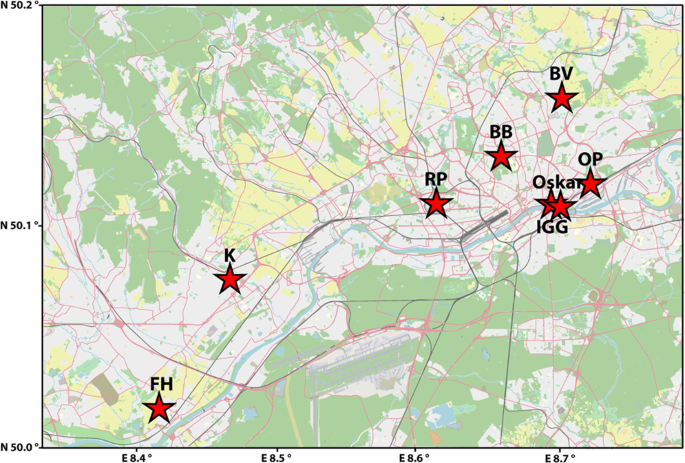
United Nations, Department of Economic and Social Affairs, P. D. World Population Prospects: The 2015 Revision, Methodology of the United Nations Population estimates and Projections. ESA/P/WP.242 (2005).
Seto, K. C., Guneralp, B. & Hutyra, L. R. Global forecasts of urban expansion to 2030 and direct impacts on biodiversity and carbon pools. Proc. Natl. Acad. Sci. 109, 16083–16088 (2012).
Grimm, N. B. et al. Global change and the ecology of cities. Science 319, 756–60 (2008).
Johnson, M. T. J. & Munshi-South, J. Evolution of life in urban environments. Science 358, eaam8327 (2017).
Pickett, S. T. A. et al. Urban Ecological Sysytems: Linking Terrestrial Ecological, Physical, and Socioeconomic of Metropolitan Areas. Annu. Rev. Ecol. Syst. 32, 127–157 (2001).
Medley, K. E., McDonnell, M. J. & Pickett, S. T. A. Forest-landscape structure along an urban-to-rural gradient. Prof. Geogr. 47, 159–168 (1995).
McDonnell, M. J. & Hahs, A. K. Adaptation and Adaptedness of Organisms to Urban Environments. Annu. Rev. Ecol. Evol. Syst. 46, 261–280 (2015).
McDonnell, M. J. & Pickett, S. T. A. Ecosystem structure and function along urban-rural gradients: an unexploited opportunity for ecology. Ecology 71, 1232–1237 (1990).
Manel, S. & Holderegger, R. Ten years of landscape genetics. Trends in Ecology and Evolution 28, 614–621 (2013).
Unfried, T. M., Hauser, L. & Marzluff, J. M. Effects of urbanization on Song Sparrow (Melospiza melodia) population connectivity. Conserv. Genet. 14, 41–53 (2012).
Delaney, K. S., Riley, S. P. D. & Fisher, R. N. A rapid, strong, and convergent genetic response to urban habitat fragmentation in four divergent and widespread vertebrates. PLoS One 5, 1–11 (2010).
Wandeler, P., Funk, S. M., Largiadèr, C. R., Gloor, S. & Breitenmoser, U. The city-fox phenomenon: Genetic consequences of a recent colonization of urban habitat. Mol. Ecol. 12, 647–656 (2003).
Munshi-South, J., Zolnik, C. P. & Harris, S. E. Population genomics of the Anthropocene: urbanization is negatively associated with genome-wide variation in white-footed mouse populations. Evol. Appl. 9, 546–564 (2016).
Bartlewicz, J., Vandepitte, K., Jacquemyn, H. & Honnay, O. Population genetic diversity of the clonal self-incompatible herbaceous plant Linaria vulgaris along an urbanization gradient. Biol. J. Linn. Soc. 116, 603–613 (2015).
Lourenço, A., Álvarez, D., Wang, I. J. & Velo-Antón, G. Trapped within the city: integrating demography, time since isolation and population-specific traits to assess the genetic effects of urbanization. Mol. Ecol. 26, 1498–1514 (2017).
Miles, L. S., Rivkin, L. R., Johnson, M. T. J., Munshi‐South, J. & Verrelli, B. C. Gene flow and genetic drift in urban environments. Mol Ecol. 00, 1–14 (2019).
McKinney, M. L. Urbanization, biodiversity, and conservation. Bioscience 52, 883–890 (2002).
Rivkin, L. R. et al. A roadmap for urban evolutionary ecology. Evol. Appl. 12, 384–398 (2019).
Culley, T. M., Sbita, S. J. & Wick, A. Population genetic effects of urban habitat fragmentation in the perennial herb Viola pubescens (Violaceae) using ISSR markers. Ann. Bot. 100, 91–100 (2007).
Soro, A., Quezada-Euan, J. J. G., Theodorou, P., Moritz, R. F. A. & Paxton, R. J. The population genetics of two orchid bees suggests high dispersal, low diploid male production and only an effect of island isolation in lowering genetic diversity. Conserv. Genet. 18, 1–13 (2016).
Purrenhage, J. L., Niewiarowski, P. H. & Moore, F. B. G. Population structure of spotted salamanders (Ambystoma maculatum) in a fragmented landscape. Mol. Ecol. 18, 235–247 (2009).
Krawiec, J. S., Krauss, L., Davis, R. A. & Spencer, P. B. S. Weak genetic structuring suggests historically high genetic connectivity among recently fragmented urban populations of the scincid lizard, Ctenotus fallens. Aust. J. Zool. 63, 279–286 (2015).
Deaton, R. et al. Effects of urbanization on genetic diversity, gene flow, and population structure in the ornate box turtle (Terrapene ornata). Amphib.-Reptil. 35, 87–97 (2014).
Theodorou, P. et al. Genome-wide single nucleotide polymorphism scan suggests adaptation to urbanization in an important pollinator, the red-tailed bumblebee (Bombus lapidarius L.). Proc. R. Soc. B Biol. Sci. 285 (2018).
Zhang, S., Suo, M., Liu, S. & Liang, W. Do Major Roads Reduce Gene Flow in Urban Bird Populations? PLoS One 8 (2013).
Munshi-South, J. Urban landscape genetics: Canopy cover predicts gene flow between white-footed mouse (Peromyscus leucopus) populations in New York City. Mol. Ecol. 21, 1360–1378 (2012).
Goldingay, R. L. et al. Fine-scale genetic response to landscape change in a gliding mammal. PLoS One 8 (2013).
Noreen, A. M. E., Niissalo, M. A., Lum, S. K. Y. & Webb, E. L. Persistence of long-distance, insect-mediated pollen movement for a tropical canopy tree species in remnant forest patches in an urban landscape. Heredity 117, 472–480 (2016).
Björklund, M., Ruiz, I. & Senar, J. C. Genetic differentiation in the urban habitat: The great tits (Parus major) of the parks of Barcelona city. Biol. J. Linn. Soc. 99, 9–19 (2010).
Beninde, J. et al. Cityscape genetics: structural vs. functional connectivity of an urban lizard population. Mol. Ecol. 25, 4984–5000 (2016).
Braaker, S., Kormann, U., Bontadina, F. & Obrist, M. K. Prediction of genetic connectivity in urban ecosystems by combining detailed movement data, genetic data and multi-path modelling. Landsc. Urban Plan. 160, 107–114 (2017).
Straub, C., Pichlmüller, F. & Helfer, V. Population genetics of fire salamanders in a pre-Alpine urbanized area (Salzburg, Austria). Salamandra 51, 245–251 (2015).
Balbi, M. et al. Functional connectivity in replicated urban landscapes in the land snail (Cornu aspersum). Mol. Ecol. 27, 1357–1370 (2018).
Balkenhol, N., Cushman, S. A., Storfer, A. T. & Waits, L. P. (Eds.). Landscape Genetics. Chichester, UK: John Wiley & Sons, Ltd (2015).
Sexton, J. P., Hangartner, S. B. & Hoffmann, A. A. Genetic isolation by environment or distance: Which pattern of gene flow is most common? Evolution. 68, 1–15 (2013).
Meirmans, P. G. The trouble with isolation by distance. Molecular Ecology 21, 2839–2846 (2012).
Wang, I. J., Glor, R. E. & Losos, J. B. Quantifying the roles of ecology and geography in spatial genetic divergence. Ecol. Lett. 16, 175–182 (2013).
Bradburd, G. S., Ralph, P. L. & Coop, G. M. Disentangling the effects of geographic and ecological isolation on genetic differentiation. Evolution 67, 3258–3273 (2013).
Delibes-Mateos, M., Ferreras, P. & Villafuerte, R. European rabbit population trends and associated factors: A review of the situation in the Iberian Peninsula. Mammal Review 39, 124–140 (2009).
Mitchell-Jones, A. et al. The Atlas of European Mammals. 484 doi:citeulike-article-id:13798298 (1999).
Delibes-Mateos, M., Delibes, M., Ferreras, P. & Villafuerte, R. Key role of European rabbits in the conservation of the western Mediterranean Basin hotspot. Conservation Biology 22, 1106–1117 (2008).
White, P. C. L. & Harris, S. In Biological Invasions: Economic and Environmental Costs of Alien Plant, Animal, and Microbe Species 113–149 (2002).
Cooke, B., Chudleigh, P., Simpson, S. & Saunders, G. The Economic Benefits of the Biological Control of Rabbits in Australia, 1950–2011. Aust. Econ. Hist. Rev. 53, 91–107 (2013).
Lees, A. C. & Bell, D. J. A conservation paradox for the 21st century: The European wild rabbit Oryctolagus cuniculus, an invasive alien and an endangered native species. Mammal Review 38, 304–320 (2008).
Smith, A.T. & Boyer, A. F. Oryctolagus cuniculus. The IUCN Red List of Threatened Species 2007. doi:e.T41291A10414811 (2007).
Ziege, M. et al. Anpassungsfähigkeit des Europäischen Wildkaninchens entlang eines rural-urbanen Gradienten. Beiträge zur Jagd- und Wildtierforsch. 38, 189–199 (2013).
Arnold, J. M., Greiser, G., Kampmann, S. & Martin, I. Status und Entwicklung ausgewählter Wildtierarten in Deutschland – Jahresbericht 2014. Wildtier-Informations- system der Länder Deutschlands (WILD) 44, https://doi.org/10.5089/9781498350891.017 (2015).
Ziege, M. et al. Importance of latrine communication in European rabbits shifts along a rural-to-urban gradient. BMC Ecol. 16 (2016).
Ziege, M. et al. From multifamily residences to studio apartments: Shifts in burrow structures of European rabbits along a rural-to-urban gradient. J. Zool. 295, 286–293 (2015).
Römer-Büchner, B. J. Verzeichniss der Steine und Thiere welche in dem Gebiete der freien Stadt Frankfurt. J.D. Sauerländer (1827).
Brinkhoff, T. City population. Population Statistics for Countries, Administrative Areas, Cities and Agglomerations—Interactive Maps and Charts; 2015 (2015).
Alberti, M., Botsford, E. & Cohen, A. In Avian Ecology and Conservation in an Urbanizing World 89–115, https://doi.org/10.1007/978-1-4615-1531-9_5 (2001).
Van Oosterhout, C., Hutchinson, W. F., Wills, D. P. M. & Shipley, P. MICRO-CHECKER: Software for identifying and correcting genotyping errors in microsatellite data. Mol. Ecol. Notes 4, 535–538 (2004).
Rousset, F. GENEPOP’007: A complete re-implementation of the GENEPOP software for Windows and Linux. Mol. Ecol. Resour. 8, 103–106 (2008).
Rice, W. R. A consensus combined p-value test and the family-wide significance of component tests. Biometrics 46, 303–308 (1990).
Peakall, R. & Smouse, P. E. GenALEx 6.5: Genetic analysis in Excel. Population genetic software for teaching and research-an update. Bioinformatics 28, 2537–2539 (2012).
Keenan, K., McGinnity, P., Cross, T. F., Crozier, W. W. & Prodöhl, P. A. diveRsity: An R package for the estimation and exploration of population genetics parameters and their associated errors. Methods Ecol. Evol. 4, 782–788 (2013).
Weir, B. S. & Cockerham, C. C. Estimating F-Statistics for the Analysis of Population Structure. Evolution (N. Y). 38, 1358 (1984).
Piry S, Luikart G, Cornuet JM BOTTLENECK: A computerprogram for detecting recent reductions in the effective population size using allele frequency data. J. Hered 90(4) 502–503 (1999).
R Core Team. R: A Language and Environment for Statistical Computing. Vienna, Austria: R Foundation for Statistical Computing, http://www.R-project.org (2013).
Jombart, T. et al. Package ‘adegenet’. Bioinforma. Appl. Note 24, 1403–1405 (2008).
Jombart, T. & Devillard, S. Discriminant analysis of principal components: a new method for the analysis of genetically structured populations. BMC Genet, https://doi.org/10.1186/1471-2156-11-94 (2010)
Kalinowski, S. T. The computer program STRUCTURE does not reliably identify the main genetic clusters within species: Simulations and implications for human population structure. Heredity (Edinb). 106, 625–632 (2011).
Wilson, G. A. & Rannala, B. Bayesian inference of recent migration rates using multilocus genotypes. Genetics 163, 1177–1191 (2003).
Wang, I. J. Examining the full effects of landscape heterogeneity on spatial genetic variation: A multiple matrix regression approach for quantifying geographic and ecological isolation. Evolution (N. Y). 67, 3403–3411 (2013).
Goslee, S. C. & Urban, D. L. The ecodist package for dissimilarity-based analysis of ecological data. J. Stat. Softw. 22, 1–19 (2007).
Bates, D., Mächler, M., Bolker, B. & Walker, S. Fitting linear mixed-effects models using lme4. J. Stat. Softw. 67, 1–48 (2015).
Munshi-South, J. & Kharchenko, K. Rapid, pervasive genetic differentiation of urban white-footed mouse (Peromyscus leucopus) populations in New York City. Mol. Ecol. 19, 4242–4254 (2010).
Calvete, C., Estrada, R., Angulo, E. & Cabezas-Ruiz, S. Habitat factors related to wild rabbit conservation in an agricultural landscape. Landsc. Ecol. 19, 533–544 (2004).
Calvete, C., Pelayo, E. & Sampietro, J. Habitat factors related to wild rabbit population trends after the initial impact of rabbit haemorrhagic disease. Wildl. Res. 33, 467–474 (2006).
Tilman, D. et al. Forecasting agriculturally driven global environmental change. Science, https://doi.org/10.1126/science.1057544 (2001).
Jongman, R. H. G. Homogenisation and fragmentation of the European landscape: Ecological consequences and solutions. Landsc. Urban Plan. 58, 211–221 (2002).
Richardson, B. J., Hayes, R. A., Wheeler, S. H. & Yardin, M. R. Social structures, genetic structures and dispersal strategies in Australian rabbit (Oryctolagus cuniculus) populations. Behav. Ecol. Sociobiol. 51, 113–121 (2002).
Parer, I. Dispersal of the Wild Rabbit (Oryctolagus cuniclus) at Urana in New South Wales. Aust. Wildl. Res. 9, 427–441 (1982).
Douglas, C. W. Movements and longevity in the rabbit. Noxious Weed Destr. Board Res. Bull. 12, 71–72 (1969).
Orsini, L., Vanoverbeke, J., Swillen, I., Mergeay, J. & De Meester, L. Drivers of population genetic differentiation in the wild: Isolation by dispersal limitation, isolation by adaptation and isolation by colonization. Molecular Ecology 22, 5983–5999 (2013).
Davey, J. et al. Genome-wide genetic marker discovery and genotyping using next-generation sequencing. Nat. Rev. Genet. 12, 499–510 (2011).
DeFries, R. & Eshleman, K. N. Land-use change and hydrologic processes: a major focus for the future. Hydrol. Process, https://doi.org/10.1002/hyp.5584 (2004).
Stodart, E. & Myers, K. A comparison of behaviour, reproduction, and mortality of wild and domestic rabbits in confined population. CSIRO Wildl. Res. 9, 144 (1964).
Carneiro, M. et al. The genetic structure of domestic rabbits. Mol. Biol. Evol. 28, 1801–16 (2011).
Hurst, C. C. Experimental Studies on Heredity in Rabbits. J. Linn. Soc. London, Zool. 29, 283–324 (1905).
DiVincenti, L., Rehrig, A. N. & Rehrig, A. N. The Social Nature of European Rabbits (Oryctolagus cuniculus). J. Am. Assoc. Lab. Anim. Sci. 55, 729–736 (2016).
Source: Ecology - nature.com



